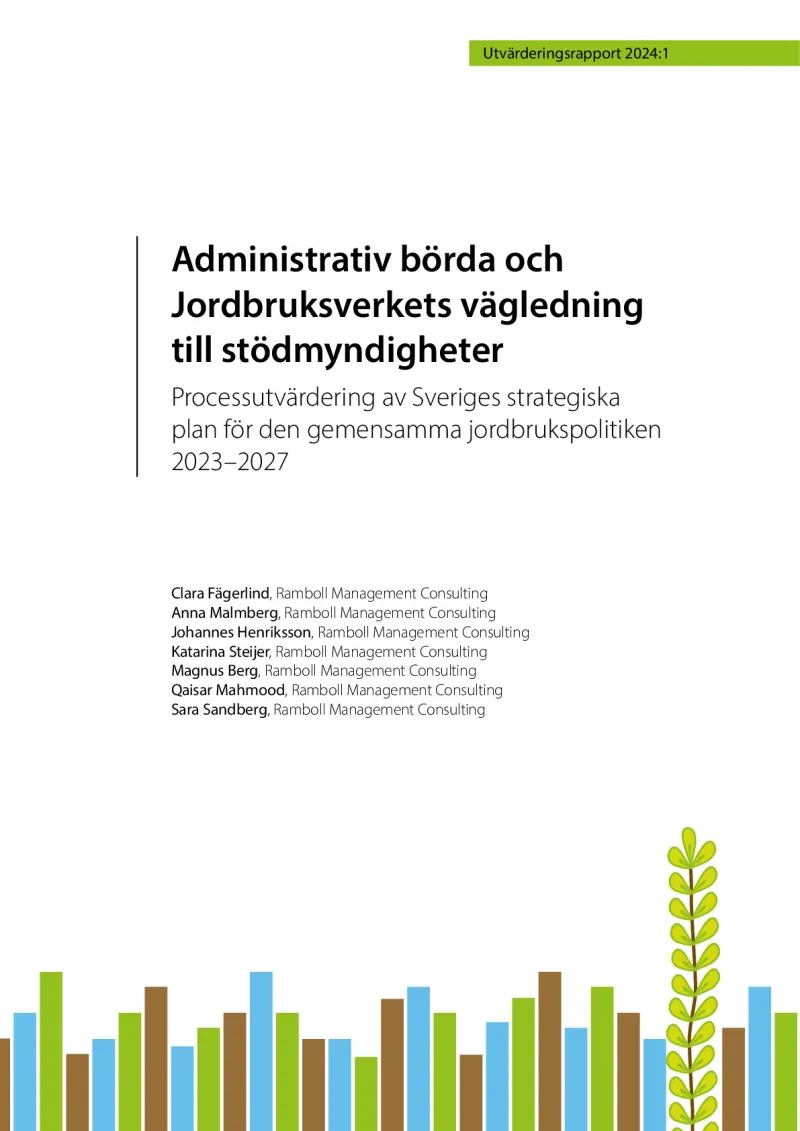Administrative burden and the board of agriculture’s guidance to administrative authorities
The report highlights how the CAP Strategic Plan's (CSP) simplifications have reduced the administrative burden to support authorities and applicants.
- Sweden
- 2023-2027
- Cross-cutting impacts

The report is the first part of a more comprehensive process evaluation structured in three studies related to the Swedish CSP 2023-2027.
This report, which covers 2023-2024, evaluates whether simplifications aimed at reducing the administrative burden have impacted beneficiaries who apply for support in the CSP and the administrative authorities responsible for processing and monitoring the applications. It also evaluates the Swedish Board of Agriculture’s work to provide guidance to the administrative authorities and whether the guidance provides the necessary support.
The process evaluation aims to identify processes and conditions that hinder or enable the implementation of the CSP.
The report meets the EU’s requirements for evaluating the CSP and considers the effectiveness and efficiency criteria.
The evaluation uses several qualitative and quantitative data collection methods. The evaluators have conducted explorative interviews with key people at the Swedish Board of Agriculture (Managing Authority) and semi-structured interviews with hand layers and administrative authorities. They have also conducted a document study and three questionnaires for applicants, field inspectors and administrative authority administrators.
The data collection has taken place logically, so the data collected in the first stage contributes to developing the questions asked in the next stage. For example, the information from the interviews with key persons at the Swedish Board of Agriculture forms the basis for the interview questions asked of representatives of the other authorities.
The evaluation answers several specific evaluation questions, with which different factors of success and methods for answering are associated.
Some limitations have been reported regarding the reliability of findings, given the response rate to primary data collection.
The evaluation highlights that, before the CSP was implemented, the Swedish Board of Agriculture introduced several amendments to simplify the process of applying for support and processing applications. The simplifications included changes in the structure and design of support, the design of the support system for applying for and managing the support scheme and a new monitoring process. These simplifications aim to reduce the administrative burden on administrators, applicants, and field inspectors. In the short term, only a few positive changes to the administrative burden can be observed.
Administrative authorities felt to a greater extent than those seeking support that the administration is not sufficiently fit for purpose, which means that it does not achieve its objectives and expected results. However, the evaluation sees that the administration can be more effective through closer cooperation between the Swedish Board of Agriculture and administrators at the administrative authorities, better needs analysis and clearer information and guidance for administrative authorities and applicants. The administration, both for administrators and for those seeking support can also become more efficient through fewer field checks and fewer questions in applications. Some of the support schemes perceived as most resource-intensive are, for example, compensation for organic production and compensation for precision farming. Support schemes within IACS (Integrated Administration and Control System) are generally easier to administer than project and investment support.
The evaluation shows that the simplifications introduced so far have led to few changes in project and investment support. One example is the extension of simplified cost options, which have had a small impact on the administrative burden. The application process, in general, can become more efficient at all stages, including by automating manual processes and information transfer in the data systems. The evaluation also shows that support authorities see opportunities to use statistics from the systems of support to continuously monitor the impact of the simplification measures on resource use and administrative burden.
Furthermore, the evaluation shows that the Swedish Board of Agriculture’s guidance has improved and corresponds more closely to the needs of the administrative authorities regarding managing and undertaking checks of support to farmers. It also reveals, among other things, that the training packages are appreciated and that the written procedures have been improved.
However, the guidance needs to be made clearer and more accessible to all administrations. The support system can also be further developed and can make the management of support authorities more efficient.
Finally, the Swedish Board of Agriculture’s guidance meets to some extent the needs of the support authorities and those applying for aid in the case of project and investment aid. There are training courses that the participants appreciate, but then it can be difficult to translate the new knowledge into practical management. Moreover, administrative authorities ask for quicker and more detailed answers from the Managing Authority to their questions. Authorities make several suggestions on how to achieve a more purpose-based and efficient management of project and investment support, including improving support systems that are perceived as difficult to navigate. With a more user-friendly and indicative application form, processing could be streamlined and the right data could be obtained directly from applicants.
Author(s)
Clara Fägerlind, Anna Malmberg, Johannes Henriksson, Katarina Steijer, Magnus Berg, Qaisar Mahmood, Sara Sandberg (Ramboll Management Consulting)